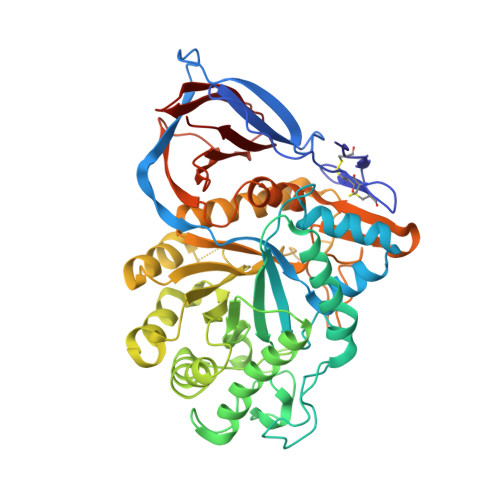Binding of 3,4,5,6-tetrahydroxyazepanes to the acid-beta-glucosidase active site: implications for pharmacological chaperone design for Gaucher disease
Orwig, S.D., Tan, Y.L., Grimster, N.P., Yu, Z., Powers, E.T., Kelly, J.W., Lieberman, R.L.(2011) Biochemistry 50: 10647-10657
- PubMed: 22047104
- DOI: https://doi.org/10.1021/bi201619z
- Primary Citation of Related Structures:
3RIK, 3RIL - PubMed Abstract:
Pharmacologic chaperoning is a therapeutic strategy being developed to improve the cellular folding and trafficking defects associated with Gaucher disease, a lysosomal storage disorder caused by point mutations in the gene encoding acid-β-glucosidase (GCase). In this approach, small molecules bind to and stabilize mutant folded or nearly folded GCase in the endoplasmic reticulum (ER), increasing the concentration of folded, functional GCase trafficked to the lysosome where the mutant enzyme can hydrolyze the accumulated substrate. To date, the pharmacologic chaperone (PC) candidates that have been investigated largely have been active site-directed inhibitors of GCase, usually containing five- or six-membered rings, such as modified azasugars. Here we show that a seven-membered, nitrogen-containing heterocycle (3,4,5,6-tetrahydroxyazepane) scaffold is also promising for generating PCs for GCase. Crystal structures reveal that the core azepane stabilizes GCase in a variation of its proposed active conformation, whereas binding of an analogue with an N-linked hydroxyethyl tail stabilizes GCase in a conformation in which the active site is covered, also utilizing a loop conformation not seen previously. Although both compounds preferentially stabilize GCase to thermal denaturation at pH 7.4, reflective of the pH in the ER, only the core azepane, which is a mid-micromolar competitive inhibitor, elicits a modest increase in enzyme activity for the neuronopathic G202R and the non-neuronopathic N370S mutant GCase in an intact cell assay. Our results emphasize the importance of the conformational variability of the GCase active site in the design of competitive inhibitors as PCs for Gaucher disease.
Organizational Affiliation:
School of Chemistry and Biochemistry, Georgia Institute of Technology, Atlanta, Georgia 30332, United States.

















